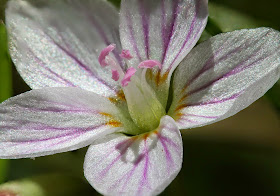The results were quite amazing! Despite the wind, the magnification afforded was significantly higher than I've used before and shown here. One of my favorites is the view across the flower at the forest of pollen-covered stigma. The stigma split at the end, forming a pir of curling lobes. As you would expect, the depth of field of the macro setup with extension tubes is quite small, and, in fact, focus-stacking was used to increase the depth of field across this view. 14 frames (!) were combined while changing focus slightly between shots to get all parts of the flower center in focus!
 But I was after smaller prey! As spotted in one of the frames yesterday, there were little pink aphids even on the just-opened flowers, so I was sort of searching for those tiny insects. I had some luck right away. This dandelion at left had a couple feeding on it, this aphid seeming to pose for me patiently while taking this 7-frame focus stack. At left is a nearly full-frame view, and the crop at right from the same image is shown at the full-camera resolution. I'm quite amazed at the resolution - pollen can be easily resolved, as well as details on the aphids, though to the naked eye they could barely be detected at all even when knowing where to look!
But I was after smaller prey! As spotted in one of the frames yesterday, there were little pink aphids even on the just-opened flowers, so I was sort of searching for those tiny insects. I had some luck right away. This dandelion at left had a couple feeding on it, this aphid seeming to pose for me patiently while taking this 7-frame focus stack. At left is a nearly full-frame view, and the crop at right from the same image is shown at the full-camera resolution. I'm quite amazed at the resolution - pollen can be easily resolved, as well as details on the aphids, though to the naked eye they could barely be detected at all even when knowing where to look! There was nothing magical about the focus-stacking, it was only used to widen the depth of field in the above image. I also shot a number of single-frame shots of our little friend, this one at left about the best one, again, showed here at the full-camera resolution. This shot was taken at just about the close-focus limit of the macro setup, so is just about as good as this setup allows...
While this stuff seems amazing, given the lowly dandelion as subject, the plant itself is pretty amazing! I found an interesting site about microscopic dandelion structure if anyone wants to learn more.
Parts of the yard are carpeted in what Melinda calls "snowdrops", and I tried imaging them though they are much harder to work with in the wind than the dandelions. They sit atop a slender stalk, and even though small, they are buffeted a lot by any breeze. This is a 7-frame focus stack, but unlike the dandelion close-ups, pollen grains can't be resolved though the color variations are striking...
Finally, later in the afternoon, another target presented itself! Canada Geese are a common sight around here all winter long as some stay even in the Midwest's cold temperatures. But yesterday the adults were seen with their goslings feeding in the yard. I grabbed a telephoto lens (a Nikon 500 F/8), and even though nearly 40 yards away, only got a couple shots before they headed into the Fox River. They err on the side of safety with potential predators, so take off when anything strange (like me!) make an appearance. We've also got a duck nest nestled against the house, but have about given up on our chance of seeing ducklings this trip...






No comments:
Post a Comment
We value your comments, but no spammers, please!